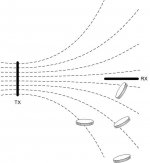I am trying to understand how the signal from this machine behaves. According to the manual the machine detects underground metallic objects when the front coil is positioned directly above the object. But now that I have been using the machine for a while, it seems that the transmission and reception of the VLF signal is not so straight forward. Especially when attempting to scan the target while at the bottom of a vertical pit a few feet underground. Hopefully someone out there knows more about how the signal can change based on ground/environmental conditions.
The first question I had was about signal strength. I had a target that was giving a very strong signal that sent the "intensity meter" past 100. The intensity of the signal remained the same until the hole reached 3-4 FT deep. At that depth I was still getting the signal over the same area but the intensity dropped to 40. It has remained at 40 all the way down to what is now a depth of 6 FT. My only guess is that the receiving coil on the back is now being blocked by more soil than it was at the surface and as a result it is now receiving a much weaker signal from the underground object. Can anyone comment on whether or not this diagram is accurate?
View attachment 1661243
The next question I had was about the form of the signal that's being transmitted by the front coil. Since I'm lacking in the necessary terminology I'll just post another diagram.
View attachment 1661244
The last question I had was about the possible ways the underground object could be detected while scanning at the bottom of a deep pit. Especially if I am only a few feet away from the object. Is it possible that the object could be received by the transmitted signal from the back coil even if the front coil is not directly above the object? Here is another diagram to better illustrate what I mean.
View attachment 1661245
Thanks for any info.
The first question I had was about signal strength. I had a target that was giving a very strong signal that sent the "intensity meter" past 100. The intensity of the signal remained the same until the hole reached 3-4 FT deep. At that depth I was still getting the signal over the same area but the intensity dropped to 40. It has remained at 40 all the way down to what is now a depth of 6 FT. My only guess is that the receiving coil on the back is now being blocked by more soil than it was at the surface and as a result it is now receiving a much weaker signal from the underground object. Can anyone comment on whether or not this diagram is accurate?
View attachment 1661243
The next question I had was about the form of the signal that's being transmitted by the front coil. Since I'm lacking in the necessary terminology I'll just post another diagram.
View attachment 1661244
The last question I had was about the possible ways the underground object could be detected while scanning at the bottom of a deep pit. Especially if I am only a few feet away from the object. Is it possible that the object could be received by the transmitted signal from the back coil even if the front coil is not directly above the object? Here is another diagram to better illustrate what I mean.
View attachment 1661245
Thanks for any info.
Upvote
0





